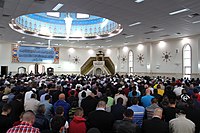
Back مهاجرت ساربانهای افغانی به استرالیا Persian Afghans (Australie) French Afghani d'Australia Italian افغانان (آسټراليا) Pashto/Pushto Афганцы (Австралия) Russian Афганці (Австралія) Ukrainian
| Part of a series on |
| Islam in Australia |
|---|
 |
| History |
|
| Mosques |
| Organisations |
| Islamic organisations in Australia |
| Groups |
| Events |
| National Mosque Open Day |
| People |
Afghan cameleers in Australia, also known as "Afghans" or "Ghans", were camel drivers who worked in Outback Australia from the 1860s to the 1930s. Small groups of cameleers were shipped in and out of Australia at three-year intervals, to service the Australian inland pastoral industry by carting goods and transporting wool bales by camel trains.
They were commonly referred to as "Afghans", even though the majority of them originated from the far western parts of British India, primarily the NWFP (Khyber Pakhtunkhwa) and Balochistan (now Pakistan), which was inhabited by ethnic Pashtuns and Balochs Nonetheless, many were from Afghanistan itself as well. In addition, there were also some with origins in Egypt and Turkey.[1] They included members of the Pashtun, Baloch, and Sindhi ethnic groups from south-central Asia (present-day Iran, Afghanistan and Pakistan); others from the Punjabi, Kashmir, and Rajasthan regions of the Indian subcontinent; as well as people from Egypt, Iraq, Syria, and Turkey.
They set up camel-breeding stations and rest-house outposts, known as caravanserai, throughout inland Australia, creating a permanent link between the coastal cities and the remote cattle and sheep grazing stations until about the 1930s, when they were largely replaced by the automobile.[1]They provided vital support to exploration, communications and settlement in the arid interior of the country where the climate was too harsh for horses.
The majority of cameleers, including cameleers from British India, were Muslim, while a sizeable minority were Sikhs from the Punjab region. They therefore played a major role in establishing Islam in Australia, building the country's first mosque at Marree in South Australia in 1861, the Central Adelaide Mosque (the first permanent mosque in Adelaide, still in use today), and several mosques in Western Australia.
Many of the cameleers and their families later returned to their homelands, but many remained and turned to other trades and ways of making a living. During the 1988 bicentennial, their contributions were recognised by The Great Australian Camel Race. Today, many people can trace their ancestry back to the early cameleers, many of whom intermarried with local Aboriginal women and European women in outback Australia.
- ^ a b Afghan cameleers in Australia. 3 September 2009. Australia.gov.au. Archived 5 August 2016 at the Wayback Machine. Accessed 8 May 2014.